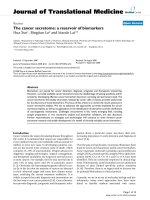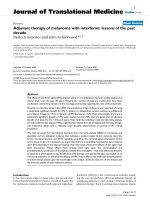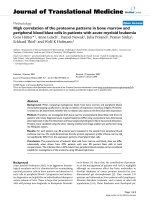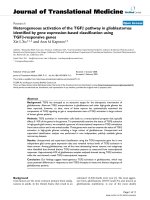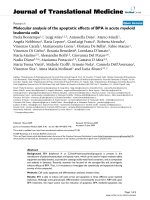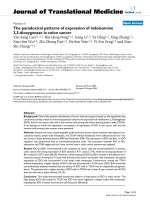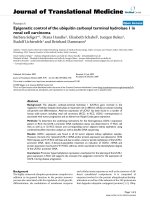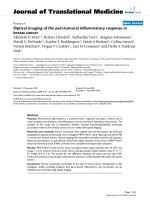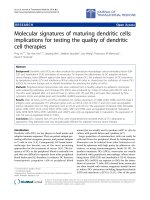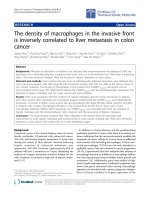báo cáo hóa học:" The use of average Pavlov ratio to predict the risk of post operative upper limb palsy after posterior cervical decompression" pot
Bạn đang xem bản rút gọn của tài liệu. Xem và tải ngay bản đầy đủ của tài liệu tại đây (571.17 KB, 9 trang )
BioMed Central
Page 1 of 9
(page number not for citation purposes)
Journal of Orthopaedic Surgery and
Research
Open Access
Research article
The use of average Pavlov ratio to predict the risk of post operative
upper limb palsy after posterior cervical decompression
Koon-Man Sieh*
1
, Siu-Man Leung
1
, Judy Suk Yee Lam
2
, Kai Yin Cheung
1
and
Kwai Yau Fung
1
Address:
1
Department of Orthopaedics and Traumatology, Alice Ho Mui Ling Nethersole Hospital, Tai Po, NT, Hong Kong SAR, PR China and
2
Department of Diagnostic Radiology and organ Imaging, The Chinese University of Hong Kong, Prince of Wales Hospital, Shatin, NT, Hong Kong
SAR, PR China
Email: Koon-Man Sieh* - ; Siu-Man Leung - ; Judy Suk Yee Lam - ;
Kai Yin Cheung - ; Kwai Yau Fung -
* Corresponding author
Abstract
Study Design: A retrospective study was conducted to study the post operative upper limb palsy
after laminoplasty for cervical myelopathy.
Objective: To identify a reliable and simple preoperative radiological parameter in predicting the
risk of post operative upper limb palsy.
Background: Post operative upper limb palsy is one of the causes of patient dissatisfaction after
surgery. There had been no simple, standard preoperative radiological parameters reliably predict
the occurrence of this problem.
Materials and methods: Seventy-four patients received posterior cervical decompression from
1998 to 2008. Medical record and preoperative radiological information were evaluated. Clinical
presentations of the palsy were described. The relationship between the occurrence of palsy and
different preoperative radiological information is analyzed.
Results: Eighteen patients (24.3%) presented with post operative upper limb palsy. Majority of
patients presented with dysesthesia (17/18) and with deficit of the C5 segment (17/18). Ten
patients presented with pure dysesthesia and 8 patients presented with mixed motor-sensory
deficit and dysesthesia. Multilevel involvement was exclusively presented in patients with motor
weakness. A longer duration of symptom (16.7 Vs 57.2 days) was noticed in patients in the motor
deficit group. Average Pavlov ratio less then 0.65 (P = 0.027, Odds Ratio = 3.68) and compression
at the C3/4 in preoperative MRI image (P = 0.025, Odds Ratio = 6) were significant risk factors for
development of this problem.
Conclusion: Post operative upper limb palsy is not uncommon and thorough preoperative
explanation is important. There is a spectrum of clinical presentation and patients with multi-level
involvement and motor deficit are associated with poorer prognosis. Average Pavlov ratio < 0.65
and compression at C3/4 segment on preoperative MRI image are simple and reliable preoperative
predictor for the development of this problem.
Published: 7 July 2009
Journal of Orthopaedic Surgery and Research 2009, 4:24 doi:10.1186/1749-799X-4-24
Received: 19 March 2009
Accepted: 7 July 2009
This article is available from: />© 2009 Sieh et al; licensee BioMed Central Ltd.
This is an Open Access article distributed under the terms of the Creative Commons Attribution License ( />),
which permits unrestricted use, distribution, and reproduction in any medium, provided the original work is properly cited.
Journal of Orthopaedic Surgery and Research 2009, 4:24 />Page 2 of 9
(page number not for citation purposes)
Introduction
Cervical myeloradiculopathy caused by compression of
the cervical cord by various pathologies remains one of
the major disease entities of the cervical spine. Lamino-
plasty is simple, safe and effective in the treatment of cer-
vical myeloradiculopathy. This technique gained
widespread acceptance and popularity since the develop-
ment of 'expansive open-door laminoplasty' by Hiraba-
yashi in 1977 [1]. This has formed the basis for the
development of various technique modifications.
Development of neurological deterioration after cervical
operation is a major clinical problem. Post operative
upper limb palsy, predominantly of the C5 segment, after
cervical laminoplasty has become one of the most notori-
ous complications affecting patients' post operative satis-
faction because of the disabling symptom of paralysis and
pain [2-14]. There is strong evidence on the association
between post operative upper limb palsy and lamino-
plasty. The reported incidence of post operative upper
limb palsy ranged from 0–30% [15]. There has been great
disparity in the incidence and definition of this complica-
tion. Although the deficit is usually transient [1-4,9,11],
long recovery time and persistent neurological symptoms
had been reported [5-8,10,13]. Moreover, there has not
been simple, standard preoperative radiological parame-
ter reliably predicting the occurrence of this complication
so far. The objective of the current study is to describe the
clinical feature and identify a preoperative predictor for
the development of post operative upper limb palsy.
Materials and methods
A retrospective study of 74 patients undergoing posterior
decompression for cervical myeloradiculopathy from
1998 to 2008 in Alice Ho Mui Ling Nethersole Hospital
was conducted. There were 48 men and 26 women with
mean age of 60.9 (23 to 89). The cause of cervical myelo-
radiculopathy included cervical spondylotic myelopathy
(n = 52), ossification of posterior longitudinal ligament
(n = 16), and cervical disc protrusion in developmental
cervical stenosis (n = 6). Expansive open-door lamino-
plasty was performed and 6 patients received additional
posterior instrumented fusion for concomitant instability.
Medical records were reviewed by the first author (SKM).
Table 1 shows their demographic characteristics and the
type and level of decompression.
Postoperative upper limb palsy was defined as having
deterioration of motor function by at least one level in
standard manual muscle testing (MMT) and/or new sen-
sory disturbance and dysesthesia with dermatomal distri-
bution after the operation. The level of neurologic
involvement was determined by the sensory dermatomal
distribution and myotome involvement as follows: del-
toid and biceps brachii – C5 segment, wrist extensors – C6
segment, triceps – C7 segment, wrist flexors and grip
power – C8 segment, intrinsic muscles – T1 segment.
Severity of clinical symptom was described using an eval-
uation scores established by the Japanese Orthopaedic
Association (JOA Score, Table 2). The total preoperative
and postoperative JOA scores and the recovery rate, by
Hirabayashi method were also calculated.
Radiologic parameters, including developmental sagittal
canal diameter and vertebral body diameter from C3 to
C6 were measured using a digital calliper on standard lat-
eral cervical radiographs. The Pavlov ratio at each level
and the average Pavlov ratio, calculated by averaging the
Pavlov ratio at C3 to C6 level, were calculated for each
patient [16-18]. (Figure 1) The alignment of the cervical
spine was classified into lordosis, straight alignment, sig-
moid alignment and kyphosis in accordance with the cri-
teria of Toyama [19]. MRI was performed in every patient
before the operation. Compression of cervical cord was
defined as any deformation of the cervical cord shown in
axial and sagittal scan of the MRI (Figure 2). The level of
compression and the multiplicity of compression were
also evaluated. The presence and location of high-signal
intensity area (HIA) in the spinal cord on T2-weighed MRI
image were recorded (Figure 3). These radiologic parame-
ters were investigated by SKM before evaluation of the
clinical notes (to minimized observer bias), and inde-
pendently by an orthopaedic specialist (LSM), and a diag-
nostic radiologist (LJS). The mean of the three
measurements was taken as final measurement to mini-
mal inter-observer error.
Statistical analysis
The differences in demographic characteristics and radio-
logic parameters, extension of decompression and degree
of recovery between those with and without postoperative
upper limb palsy were tested by t-test and χ
2
test as appro-
priate. Univariated analyses were performed to estimate
the odds ratios of various radiologic parameters, exten-
sion of decompression and various risk factors for devel-
opment of postoperative upper limb palsy. Statistical
significance was defined by a p-value of less than 0.05. All
statistical analyses were performed using by SPSS version
16.
Results
Post operative upper limb palsy
Eighteen patients (24.3%) developed post operative
upper limb palsy between 1 and 7 days after surgery
(mean 2.6 days). There was no report on the deterioration
of neurological status immediately after the operation.
Recovery rate
postop score preop score maximal score
(%)
(. .)/(=- ´preop score.) %100
Journal of Orthopaedic Surgery and Research 2009, 4:24 />Page 3 of 9
(page number not for citation purposes)
There were no significant difference in gender, age at sur-
gery, etiology, duration of symptom before surgery, level
of decompression, pre- and postoperative JOA scores and
recovery rate between patients with and without postop-
erative upper limb palsy (Table 1).
Ten patients presented with pure dysesthesia over the C5
dermatome and eight patients presented with motor
weakness mixed with sensory deficit and dysesthesia. (Fig-
ure 4) All except one patient had C5 level involvement.
The level of cervical segment involvement was showed in
table 3. Multi-level involvement occurred exclusively in
patients with motor weakness. Majority of these patients
(7/8) presented with mixed dysesthesia, motor and sen-
sory deficit. Twelve patients presented with unilateral
symptom. Six patients presented with bilateral symptoms.
All except one patient recovered completely from their
symptom, with an average of 33.1 days (1–182 days).
Twelve of the 18 patients required simple analgesic and
six patients required anxiolytic and gabapentin for symp-
tomatic relief. One patient presented with bilateral shoul-
der pain on the first post operative day followed by
progressive weakness of both upper limb. Improvement
was slow and functional recovery (MMT > 3/5) was not
achieved in the latest follow-up on the 4
th
post operative
month. Those having motor weakness was older (66 Vs 58
years) and suffering from longer duration of symptom (5–
182 days, mean = 57.3 days) than patient with pure dys-
esthesia (1–95 days, mean = 16.7 days). The difference
was short of statistical significance (p = 0.082). (Table 4)
Radiological data
The mean Pavlov ratio at each level and the Average Pav-
lov ratio were smaller in patient with post operative upper
limb palsy but statistical significance was not able to dem-
onstrate (Table 5). Figure 5 shows the distribution of
Average Pavlov ratio and the quartile value of our patients.
Table 6 shows the results of the univariate analyses.
Patients having severe cervical canal stenosis, defined as
an Average Pavlov ratio of less than 1
st
quartile, (0.65)
(OR 3.38, p = 0.027) were significantly more likely to
develop postoperative upper limb palsy.
Table 1: Demographic and other characteristics of the patients
Patient without palsy (n = 56) Patient with Palsy (n = 18)
Sex (M/F) 36/20 12/6
Mean age at surgery (years) 60.63 61.61
Duration of symptom before operation (months) 12.42 15.06
Disease etiology (%)
- CSM 40 (71.4) 12 (66.7)
- OPLL 11 (19.6) 5 (27.8)
- PID 5 (8.9) 1 (5.6)
Type of operation (%)
- Laminoplasty 53 (94.6) 15 (83.3)
- Posterior decompression with internal fixation 3 (5.4) 3 (16.7)
Extent of decompression (%)
- C2–C7 1 (1.8) 0 (0)
- C3–C7 25 (44.6) 9 (50)
- C3–C6 21 (37.5) 8 (44.4)
- C3–C5 4 (7.1) 0 (0)
- C4–C7 3 (5.4) 0 (0)
- C4–C6 2 (3.6) 1 (5.6)
Mean Preoperative JOA score 10.55 11.22
Mean Postoperative JOA score 13.66 14.22
Recovery rate (%) 52.37 48.34
CSM = cervical spondylotic myelopathy; OPLL = ossification of the posterior longitudinal ligament; PID = Protrusion of cervical disc in
developmental cervical stenosis
*All statistically not significant
Journal of Orthopaedic Surgery and Research 2009, 4:24 />Page 4 of 9
(page number not for citation purposes)
Compression of cervical cord in preoperative MRI was
most commonly occurring at the mid-cervical level (Table
6). C4/5 level in 56 patients (71.8%), followed by C5/6 in
52 patients (66.7%) and C3/4 in 48 patients (64.9%).
However, compression at C3/4 level is showed to associ-
ate with higher risk of occurrence of palsy (OR 6, p =
0.025). Multiplicity of compression, defined by 3 or more
compression from preoperative MRI, showed higher rate
of development of post operative upper limb palsy
(73.2% Vs 48.2%) with marginal statistical significance (p
= 0.082). The association between palsy and preoperative
alignment, intramedullary high-signal intensity area
(HIA) on preoperative T2-weighted MRI were not signifi-
cant.
Discussion
Post operative upper limb palsy after cervical lamino-
plasty posterior has raised substantial concern in the past
20 years but controversies still remain in the nomencla-
ture, pathophysiology and defining the risk factors for the
development of this significant complication. 'Post oper-
ative C5 palsy', defined by unilateral paralysis of the del-
toid and biceps muscles without sensory disturbance
[2,3,20] is one of the commonly used definitions among
surgeons. At the same time, there are considerable con-
cerns about the multilevel motor paralysis after the sur-
gery [4-10,21,22], which led to the evolution of different
nomenclatures like 'Segmental motor paralysis' [4-6],
'Post operative muscle weakness of the upper extremities'
[8], 'Post operative motor paralysis of the upper limb' [10]
and 'upper extremity palsy' [7,22]. Moreover, some
authors who also include pain and sensory disturbance in
describing this problem [5,7,9,11,13,14]. In this study, we
defined postoperative upper limb palsy as having deterio-
ration of motor function by at least one level in standard
manual muscle testing (MMT) and/or new sensory distur-
bance and dysesthesia with dermatomal distribution after
the operation.
Narrow spinal canal is associated with higher risk for the
development of cervical myelopathy [16-18]. Edwards et
al. defined narrow spinal canal by direct measurement of
the midcervical diameter from standard lateral cervical
radiograph. Measurement less then 13 mm is prone to
development cervical myelopathy [18]. The use of Pavlov
ratio eliminated the discrepancy of magnification and had
been generally accepted an essential radiological parame-
ter in management of cervical myeloradiculopathy. Pav-
lov ratio less then 0.82 are considered stenotic [17] and
are associated with a higher risk of cervical myelopathy.
Yue et al. echoed the work of Pavlov and concluded that
Average Pavlov ratio might be a useful predictor to cervical
myelopathy [17]. However, the association of narrow spi-
nal canal with the risk of post operative upper limb palsy
has not been clearly established.
Recognizing the substantial proportion of multi-level
involvement in our patient with the post operative upper
limb palsy, we hypothesize that pathological insults to the
cervical cord adopted a similar 'multi-level' fashion. We
Table 2: Japanese Orthopaedic Association Score
JOA SCORE
I. Motor function of the upper extremity 0. Impossible to eat with chopsticks or spoon
1. Possible to ear with spoon, but not with chopsticks
2. Possible to eat with chopsticks, but inadequate
3. Possible to eat with chopsticks, but awkward
4. Normal
II. Motor function of the lower extremity 0. Impossible to walk
1. Needs cane or aid on flat ground
2. Needs cane or aid only on stairs
3. Possible to walk without cane or aid but slowly
4. Normal
III. Sensory function A. Upper extremity
0. Apparent sensory loss
1. Minimal sensory loss
2. Normal
B. Lower extremity (same as A)
Trunk (same as A)
IV. Bladder function 0. Complete retention
1. Severe disturbance (sense of retention, dribbling, incomplete continence)
2. Mild disturbance (urinary frequency, urinary hesitancy)
3. Normal
Journal of Orthopaedic Surgery and Research 2009, 4:24 />Page 5 of 9
(page number not for citation purposes)
also hypothesize that patients with developmental cervi-
cal stenosis, implied by a small Average Pavlov ratio, will
have higher risk for developing postoperative palsy. A
developmentally narrowed spinal canal made cord com-
pression more likely. On the other hand, there may be
inherent factors associating with the narrowing which
render the cord more susceptible to pathological insults,
e.g. peculiar blood supply, or as a result of reperfusion
after decompression of multi-level compression [15].
Since our patients were all suffering from symptomatic
cervical myeloradiculopathy, the distribution of Average
Pavlov ratio is expected to be skewed instead of normal,
which justified the transformation of the Average Pavlov
ratio into a categorical variable. We used the 1
st
quartile as
the cut off for defining extremely narrow spinal canal, for
subsequent analyses (Figure 5). We are able to show a sig-
nificantly higher risk of developing postoperative palsy in
patients having an Average Pavlov ratio of less then 0.65
with an odds ratio of 3.68. Moreover, there was a higher
rate of post operative upper limb palsy in patient with 3
or more compression on preoperative MRI with marginal
statistical significance. These results support our assump-
tion that an extremely narrow cervical spinal canal is
prone to development of post operative upper limb palsy.
Majority of our patients present with dysesthesia (17/18)
and had neurologic deficit involving the C5 segment (17/
18). We showed compression at the C3/4 level is strongly
associated with the development of palsy. Since anatomi-
The sagittal diameter of the spinal canal (a) is measured from the posterior point of the corresponding spinal laminar lineFigure 1
The sagittal diameter of the spinal canal (a) is meas-
ured from the posterior point of the corresponding
spinal laminar line. The sagittal diameter of the vertebral
body (b) is measured at the midpoint, from the anterior sur-
face to the posterior surface. The spinal canal/vertebral body
ratio is determined with the formula a/b as Pavlov ratio.
Preoperative MRI image showing compression of the cervical cord at C5/6Figure 2
Preoperative MRI image showing compression of the
cervical cord at C5/6. A, sagittal T2-weighted MRI image.
B, corresponding axial T2-weighted MRI image showing
deformation of the C5/6 by the compression. C, no deforma-
tion of the cord at C4/5.
High-signal intensity area in the C3/4 segment in T2-weighted MRI imageFigure 3
High-signal intensity area in the C3/4 segment in T2-
weighted MRI image.
Journal of Orthopaedic Surgery and Research 2009, 4:24 />Page 6 of 9
(page number not for citation purposes)
cal study showed C3/4 level corresponds to the C5 cord
segment [23], it is reasonable to assume compression of
C5 segment is a strong contributing factor in the develop-
ment of post operative upper limb palsy and this also
explained the predilection of C5 neurologic dysfunction.
There is no significant difference in JOA score and recov-
ery rate between patients with and without the palsy in
this study. Since the effect of post operative upper limb
palsy is transient, most of the patients had already recov-
ered during the follow up review in this retrospective
study. Further this may be the limitation of the JOA score
Table 3: Summary of patients with post operative upper limb palsy
Case no. Age (yr)/Sex Etiology Presentation Onset (days) Duration of
recovery
(days)
Laterality Level of
involvement
HIA on
preop. MRI
Dysesthesia Sensory
deficit
Motor deficit
(MMT)
1 72/M CSM Yes No No 5 2 Left C5 -
2 80/M CSM Yes No Yes
(4 to -3)
7 42 Left C5 C3/4, C6/7
3 71/F CSM Yes No Yes (5 to 4) 2 42 Bilateral C5, C8 C5
454/FCSMYes No No 1 8 LeftC5 C6/7
5 50/M OPLL Yes Yes Yes (5 to 3) 1 31 Right C6, C7 C3/4
6 74/M CSM Yes No No 3 95 Right C5 C3/4, C5/6
7 51/M CSM Yes No Yes (5 to 4) 4 5 Right C5–7 C4/5
8 50/M PID Yes No No 3 1 Right C5 C3–5
9 54/M CSM Yes No No 6 1 Right C5 -
10 78/M CSM Yes No Yes
(4 to -3)
1 21 Bilateral C5–6 C5/6
11 49/F OPLL Yes No No 2 2 Left C5 -
12 68/F OPLL Yes Yes Yes (5-4) 1 182 Bilateral C5, C8, T1 -
13 61/F OPLL Yes No No 1 15 Left C5 C4/5
14 49/M CSM Yes No No 1 27 Bilateral C5 -
15 59/F OPLL Yes No No 1 11 Bilateral C5 -
16 84/M CSM No No Yes (4-3) 4 15 Left C5–7 C3/4, C6/7
17 60/M CSM Yes No No 2 5 Right C5 C4/5, C5–6
18 45/M CSM Yes No Yes (5-0) 1 120 Bilateral C5-T1 C3/4, C6/7
CSM = cervical spondylotic myelopathy; OPLL = ossification of the posterior longitudinal ligament; PID = Protrusion of cervical disc in
developmental cervical stenosis; MMT = Manual muscle testing; HIA = T2 high-signal intensity area in the spinal cord;
Distribution of presentation in patients with post operative upper limb palsyFigure 4
Distribution of presentation in patients with post
operative upper limb palsy.
5
2
10
1
Pure dysesthesia
Motor deficit and
dysesthesia
Motor and sensory
deficit with dysesthesia
Motor deficit only
Journal of Orthopaedic Surgery and Research 2009, 4:24 />Page 7 of 9
(page number not for citation purposes)
Table 4: Characteristic between patients with and without motor weakness
Pure dysesthesia
(n = 10)
Dysesthesia with motor deficit
(n = 8)
P
Mean age (years) 58.2 65.9 0.199
Mean recovery time (days) 16.7 57.3 0.082
Sex (M/F) 6:4 6:2 0.502
HIA in T2-weighted MRI (%) 5 (50) 7 (87.5) 0.152
Table 5: Pavlov ratios of patients with and without postoperative upper limb palsy
Patient without palsy
(n = 56)
Patient with palsy
(n = 18)
P
Pavlov ratio (mean)
C3 0.7125 0.6916 0.363
C4 0.6870 0.6701 0.495
C5 0.6836 0.6805 0.890
C6 0.7198 0.6783 0.058
Average 0.7017 0.6804 0.271
Table 6: Odds ratio of potential risk factors for development of postoperative upper limb palsy
Patient without palsy
(n = 56)
Patient with palsy
(n = 18)
OR p
Average Pavlov ratio < 0.65 10 (17.9) 8 (44.4) 3.68 0.027
Level of compression in Preoperative MRI (%)
C2/3 (%) 3 (5.4) 1 (5.6) 1.039 0.974
C3/4 (%) 32 (57.1) 16 (88.9) 6 0.025
C4/5 (%) 40 (71.4) 16 (88.9) 3.2 0.149
C5/6 (%) 42 (75.0) 10 (55.6) 0.417 0.122
C6/7 (%) 25 (44.6) 10 (55.6) 1.55 0.421
C7/T1 (%) 1 (1.8) 0 (0)
3 or more compression levels in MRI (%) 27 (48.2) 13 (72.2) 2.79 0.082
HIA in T2 weighted MRI image (%) 44 (78.6) 11 (61.1) 0.955 0.943
Journal of Orthopaedic Surgery and Research 2009, 4:24 />Page 8 of 9
(page number not for citation purposes)
in reflecting the functional disturbance attributed by the
post operative upper limb palsy.
Although many researchers has suggested different preop-
erative and intraoperative monitor in detecting the occur-
rence and evaluating the risk of post operative upper limb
palsy, they usually involved specially trained personnel
and sophisticated equipment [2,11,20-22]. In our pilot
study using measuring ruler in measuring the Average
Pavlov ratio, same conclusion (0.65) can be reached. This
suggested simple measuring technique is also applicable
when using Average Pavlov ratio to predict the risk of
occurrence of palsy. Our study is able to demonstrate
these two preoperative radiological parameters are sim-
ple, reliable in predicting this significant post operative
complication of posterior cervical decompression.
Finally, this is the drawback of the current study of small
population size. The dose-effect of spinal canal narrowing
to the development of post operative upper limb palsy
was not able to demonstrate and causing statistical insig-
nificant or marginal significant in variable parameters.
Conclusion
Post operative upper limb palsy is a significant post oper-
ative complication of cervical posterior decompression
that thorough preoperative explanation is important.
Spectrum of presentation from pure dysesthesia to multi-
level, motor sensory dysfunction is demonstrated. Patient
presented with multi-level involvement and motor dys-
function is associated with longer recovery period. Aver-
age Pavlov Ratio of less then 0.65 and cervical cord
compression of C3/4 level in preoperative MRI could be
simple and reliable predictors for the development of post
operative upper limb palsy
Competing interests
The authors declare that they have no competing interests.
Authors' contributions
All authors had substantial contributions to conception
and design of the study and giving final approval to the
manuscript. KMS, SML and JSYL participated in the data
acquisition. KMS is responsible for data interpretation
and writing of the manuscript. All authors have read and
approved the final manuscript.
Acknowledgements
The authors cordially appreciate the assistance from the nursing staff of the
Department of Orthopaedics and Traumatology, Alice Ho Mui Ling Neth-
ersole Hospital in preparation of clinical materials. We would like to appre-
ciate Dr. PS Ng for his assistance in statistical analysis of the data in this
study.
References
1. Hirabayashi K, Watanabe K, Wakano K, Suzuki N, Ishii Y: Expansive
Open-Door Laminoplasty for Cervical Spinal Stenotic Mye-
lopathy. Spine 1983, 8(7):693-9.
2. Tanaka N, Nakanishi K, Fujiwara Y, Kamei N, Ochi M: Postopera-
tive segmental C5 palsy after cervical laminoplasty may
occur without intraoperative nerve injury: a prospective
study with transcranial electric motor-evoked potentials.
Spine 2006, 31(26):3013-7.
3. Minoda Y, Nakamura H, Konishi S, Nagayama R, Suzuki E, Yamano Y,
Takaoka K: Palsy of the C5 nerve root after midsagittal-split-
ting laminoplasty of the cervical spine. Spine 2003,
28(11):1123-7.
4. Chiba K, Ogawa Y, Ishii K, Takaishi H, Nakamura M, Maruiwa H, Mat-
sumoto M, Toyama Y: Long-term results of expansive open-
door laminoplasty for cervical myelopathy – average 14-year
follow-up study. Spine 2006, 31(26):2998-3005.
5. Sakaura H, Hosono N, Mukai Y, Fujii R, Iwasaki M, Yoshikawa H: Seg-
mental motor paralysis after cervical laminoplasty: a pro-
spective study. Spine 2006, 31(23):2684-8.
6. Chiba K, Toyama Y, Matsumoto M, Maruiwa H, Watanabe M, Hiraba-
yashi K: Segmental motor paralysis after expansive open-
door laminoplasty. Spine 2002, 27(19):2108-15.
7. Hasegawa K, Homma T, Chiba Y: Upper extremity palsy follow-
ing cervical decompression surgery results from a transient
spinal cord lesion. Spine 2007, 32(6):E197-202.
8. Satomi K, Ogawa J, Ishii Y, Hirabayashi K: Short-term complica-
tions and long-term results of expansive open-door lamino-
plasty for cervical stenotic myelopathy. Spine J 2001,
1(1):26-30.
9. Komagata M, Nishiyama M, Endo K, Ikegami H, Tanaka S, Imakiire A:
Prophylaxis of C5 palsy after cervical expansive laminoplasty
by bilateral partial foraminotomy. Spine J 2004, 4(6):650-5.
10. Seichi A, Takeshita K, Kawaguchi H, Nakajima S, Akune T, Nakamura
K: Postoperative expansion of intramedullary high-intensity
areas on T2-weighted magnetic resonance imaging after cer-
vical laminoplasty.
Spine 2004, 29(13):1478-82.
11. Sasai K, Saito T, Akagi S, Kato I, Ohnari H, Iida H: Preventing C5
palsy after laminoplasty. Spine 2003, 28(17):1972-7.
12. Kaminsky SB, Clark CR, Traynelis VC: Operative treatment of
Cervical Spondylotic Myelopathy and Radiculopathy: A com-
parison of Laminectomy and Laminoplasty at five year aver-
age follow-up. Iowa Orthop J 2004, 24:95-105.
13. Uematsu Y, Tokuhashi Y, Mtsuzaki H: Radiculopathy after Lami-
noplasty of the Cervical Spine. Spine 1998, 23(19):2057-62.
14. Yonenobu K, Hosono N, Iwasaki M, Asano M, Ono K: Neurologic
complications of surgery for cervical compression myelopa-
thy. Spine 1991, 16(11):1277-82.
15. Hirabayashi K, Miyakawa J, Satomi K, Maruyama T, Wakano K: Oper-
ative results and postoperative progression of ossification
among patients with ossification of cervical posterior longi-
tudinal ligament. Spine 1981, 6(4):354-64.
16. Pavlov H, Torg JS, Robie B, Jahre C: Cervical Spinal Stenosis:
determination with Vertebral Body Ratio Method. Radiology
1987, 164(3):771-5.
Distribution of Average Pavlov ratio for all patients and the Quartile valuesFigure 5
Distribution of Average Pavlov ratio for all patients
and the Quartile values.
0
1
2
3
4
5
6
7
8
9
10
11
12
0.55 0.6 0.65 0.7 0.75 0.8 0.85
Num ber
of patients
1st Quartile
(0.65)
3rd Quartile
(0.75)
2nd Quartile
(0.69)
Publish with BioMed Central and every
scientist can read your work free of charge
"BioMed Central will be the most significant development for
disseminating the results of biomedical research in our lifetime."
Sir Paul Nurse, Cancer Research UK
Your research papers will be:
available free of charge to the entire biomedical community
peer reviewed and published immediately upon acceptance
cited in PubMed and archived on PubMed Central
yours — you keep the copyright
Submit your manuscript here:
/>BioMedcentral
Journal of Orthopaedic Surgery and Research 2009, 4:24 />Page 9 of 9
(page number not for citation purposes)
17. Yue WM, Tan SB, Tan MH, Koh DCS, Tan CT: The Torg-Pavlov
Ratio in Cervical Spondylotic Myelopathy. Spine 2001,
26(16):1760-4.
18. Edwards WC, LaRocca H: The Developmental Segmental Sag-
ittal Diameter of the Cervical Spinal Canal in Patients with
Cervical Spondylosis. Spine 1983, 8(1):20-7.
19. Chiba K, Toyama Y, Watanabe M, Maruiwa H, Matsumoto M, Hiraba-
yashi K: Impact on Longitudinal Distance of the Cervical
Spine on the Results of Expansive Open-door Laminoplasty.
Spine 2000, 25(22):2893-8.
20. Fan D, Schwartz DM, Vaccaro AR, Hilibrand AS, Albert TJ: Intraop-
erative neurophysiologic detection of iatrogenic C5 nerve
root injury during laminectomy for cervical compression
myelopathy. Spine 2002, 27(22):2499-502.
21. Kaneko K, Hashiguchi A, Kato Y, Kojima T, Imajyo T, Taguchi T:
Investigation of motor dominant C5 paralysis after lamino-
plasty from the results of evoked spinal cord responses. J Spi-
nal Disord Tech 2006, 19(5):358-61.
22. Park P, Lewandrowski KU, Ramnath S, Benzel EC: Brachial neuritis:
an under-recognized cause of upper extremity paresis after
cervical decompression surgery. Spine 2007, 32(22):E640-4.
23. Kubo Y, Waga S, Kojima T, Matsubara T, Kuga Y, Kakagawa Y: Micro-
surgical Anatomy of the Lower Cervical Spine and Cord.
Neurosurgery 1994, 34(5):895-902.
